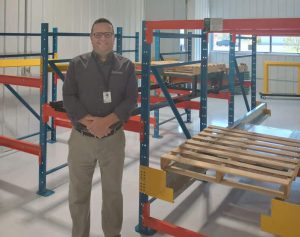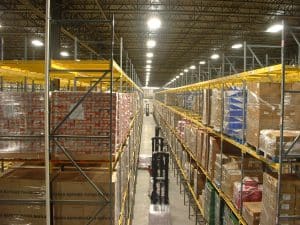Stick with OEM Parts When Replacing Racking Components
Posted on Feb 4, 2025
Adding Pallet Rack Parts from Different Manufacturers Can Weaken the System
Beams, uprights, braces and other elements of a pallet racking system often need to be replaced due to damage caused by forklift impacts or other causes. When that situation arises, it’s important to replace the components with parts from the same manufacturer, and not from another source.

Chris Aprile of Steel King
“Mixing storage rack components from different OEMs (original equipment manufacturers) can have several negative effects that could compromise the structural integrity, safety and overall performance of a storage rack system,” says Chris Aprile, Senior Structural Engineer with Steel King Industries.
Forklift impacts are the most common cause of damage to pallet racking parts, especially where manual lifts are still being used.
“Warehouses throughout the United States have a variety of different types of manual or automated forklifts,” Aprile notes. “Where they are still using manual forklifts, there is a higher probability of damage; it’s just human nature. The driver might be going faster than he should, sometimes due to pressure to load and unload products more quickly.”
But other factors can lead to mixed components, such as when installers who are under a tight deadline realize a part is missing, prompting them to order a different manufacturer’s part. Aprile highlights five key issues that can arise when replacing racking components with those from a different OEM:
- Compatibility
- Structural Integrity and Safety
- Warranty and Liability Concerns
- Seismic Area Performance
- Installation Factors
Compatibility issues relate to design differences and the incompatibility of connections among manufacturers. Depending on the OEM, the steel characteristics could differ, and various pallet rack parts could have different dimensions and contribute differently to load capacity.
“Each manufacturer may design components with unique dimensions, materials, and tolerances, making it difficult to mix and match components,” Aprile notes. “Misaligned parts can lead to improper fit-up, affecting the stability of the structure.”
 Additionally, he says, different OEMs often use proprietary connection types. That can make it impossible to secure components together safely, creating weak points in the system.
Additionally, he says, different OEMs often use proprietary connection types. That can make it impossible to secure components together safely, creating weak points in the system.
Structural integrity can be compromised when pallet rack parts are mixed. According to Aprile, “using components from different manufacturers can lead to uncertainty about the overall load-bearing capacity, as the system may not perform as designed. This can increase the risk of overloading and collapse.”
Normal wear-and-tear creates another integrity issue. “In any racking system, in use over the years under different temperature conditions with expansion and contraction, and being bumped into, can experience a keyhole being elongated. Or, taking a beam off a shelf and putting it two to three inches down in another keyhole and in the process, you damage the keyhole — all that can weaken the joint, the connection,” Aprile says. “Even if a part was perfect after 20 years, the keyhole might not be compatible with our rivet, because it was made by a different manufacturer.”
Further, mismatched components can create weak joints, leading to a lack of structural continuity and reduced system strength – particularly under dynamic loads, he adds.
Going forth, as jurisdictions adopt the new IBC building code and related RMI 2023 standards, it could be more challenging to replace a component designed to meet older codes with components that must meet current codes.
Warranty and liability concerns are another issue when mixing components. Aprile points out that most manufacturers will void warranties if their components are mixed with those from other OEMs, leaving the owner responsible for any defects or failures. And, insurance companies might deny a claim if they determine non-compatible components contributed to a system failure.
Performance of a racking system in a seismic area could be compromised when pallet rack parts are mixed, Aprile says, noting that “different manufacturers may design racks to meet specific seismic performance criteria. Mixing components could lead to conflicting design assumptions, reducing the system’s ability to withstand seismic forces.” An example of this issue arising would be when a component is needed for a racking system in a high seismic area, and that part is obtained from a related warehouse in a neighboring state where the likelihood of seismic activity is less.
Installation problems could surface when pallet rack parts from different manufacturers are used. Even small differences in component sizes or connection types can result in significant problems during installation, causing delays and increasing labor costs, Aprile says. During assembly of a system, installers might find that pallet rack parts from different manufacturers misalign due to different fabrication tolerances used in the manufacturing process.
While it’s not related to structural integrity, aesthetics is another issue when mixing components. For many companies that protect their brand identity, it’s important that racking elements support the brand, Aprile notes. “Brand identity can be very important to a company, which is why we offer so many different colors,” he says.
Finally, mixing components is discouraged by RMI, the Rack Manufacturers Institute. RMI advises that a damaged portion of rack should be repaired and restored to at least its original design capacity, then certified by a licensed professional engineer.
RMI’s guideline for replacing damaged pallet rack parts says, “When original or updated engineering documentation is available, replacement of damaged components with identical parts from the original manufacturer is an approved method to address the damaged rack, as long as the rack system still meets appropriate capacity requirements. It is important to not interchange uprights, beams or other components that look ‘similar’ to each other.”
To ensure the safety, performance, and longevity of your pallet racking system, always replace damaged components with parts from the original manufacturer. Steel King offers a comprehensive range of pallet rack systems and replacement parts to meet your needs. Use our distributor locator to find a trusted supplier near you and maintain the integrity of your storage system.
